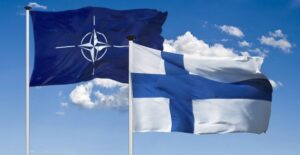- Since joining the European Union, Poland has experienced exponential economic growth.
- Since the beginning of the war in Ukraine, Warsaw has been a leader in supporting Ukraine and calling for a stronger response from the international community.
- Poland has increased its spending on defense and the modernization of its military equipment, enhancing its leadership position in Eastern Europe and its importance in the European Union.
Poland has been striving to position itself as a regional power center, strengthening ties with other countries in Central and Eastern Europe and seeking to lead initiatives in areas such as energy, infrastructure and military cooperation.
One of the main contributions of the war in Ukraine to the process of strengthening Poland was the increase in the perception of a threat to national security, which led the country to increase its military spending and defense investments.
In addition, Poland played an important role in mediating conflicts and supporting Ukraine during the crisis, which increased its international visibility and relevance.
Other factors that have contributed to Poland’s rise include its strong economy and strategic position in Central Europe, as well as its leading role in EU and NATO/NATO related issues, aspects that could shift the regional balance of power.

The growing Polish economy and development since its entry into the European Union
As of June 2003, over 13.5 million Polish citizens have agreed to Poland’s accession to the European Union. Less than a year later, on May 1, 2014, Warsaw became an official member of the bloc.
Poland’s accession to the EU resulted in a significant increase in the country’s economic growth. In 2018, Poland’s GDP per capita had increased by 81% since 2003, and despite difficulties – such as the post-pandemic and the war in Ukraine – the European Commission confirmed Polish economic growth in 2022, with a forecast of 4, 9%.
Currently, the Polish economy is one of the fastest growing within the EU, with an annual GDP of 689.349 million dollars, and the wealth of Polish citizens is gradually catching up with that of the richest countries in Europe. Therefore, it is believed that by 2030, Poland could become one of the 20 largest economies in the world.
However, in recent years, Poland has been the target of criticism by many international observers, due to an alleged process of weakening democracy and increasing authoritarianism in the country. The government led by the Law and Justice (PiS) party, which has been in power since 2015, has implemented a series of changes to the structure of the state, the judiciary, the media and other areas that many critics argue undermine democratic principles.
Among the most controversial decisions implemented by the Polish government in recent years is the reform of the judiciary, which included the creation of a judicial oversight body, the lowering of the retirement age of judges, and the replacement of judges from the Supreme Court and the Constitutional Court.
Furthermore, the PiS government has also been criticized for its approach towards the media. The government has created a new news agency that many see as an attempt to control the media narrative, and there have been concerns about a lack of plurality and diversity in Polish media.
These measures, along with other controversial government policies, have led many international observers to argue that Poland is moving towards an autocratic system. However, it is important to note that there are differing opinions on this issue and that there are also many Poles who support the government’s policies.
How the war in Ukraine is contributing to Poland becoming a military power within Europe
Through the historical knowledge of the invasions carried out by other States in Polish territory, it is possible to understand the reasons why Warsaw has a great desire to develop as a great regional military power.
The Russian invasion of Polish territory dates back to the 18th and 19th centuries, when the Russian Empire tried to annex parts of Poland. During World War I, Russia occupied much of Polish territory, before being expelled by Germany.
Between the two world wars, Poland and the Soviet Union clashed over control of Ukraine and Belarus, with the Soviet Union invading the eastern part of Poland in 1939, followed by Germany invading the western part, as per their agreement. secret.
During World War II, Poland was occupied by Nazi Germany and the Soviet Union, which invaded the country again in 1944. After the war, Poland became a satellite state of the Soviet Union, governed by the Polish Communist Party until 1989.
Since Russia annexed Crimea in 2014 and the war in eastern Ukraine intensified, Poland has been one of the most active countries in supporting Ukraine and calling for a response from the international community. Poland has provided military assistance, including training and weapons, to Ukrainian forces and has been a strong advocate of EU sanctions against Russia.
Even before the biggest Russian invasion of Ukraine in 2022, Poland was already home to more than 1 million Ukrainian immigrants on its territory.
This position Poland’s role has been recognized by other NATO countries and, in particular, by the United States, which has been increasing its military presence in Poland since 2014. Poland has been an important partner for NATO in Central Europe and has led several military exercises of NATO in the region, with the aim of improving the interoperability of military forces.
In addition, Poland has been increasing its defense spending and modernizing its military equipment, including the acquisition of new fighter planes and warships. Poland has also sought greater cooperation with other Central European countries such as the Czech Republic, Hungary and Slovakia in creating a joint defense force.
Recent agreements for the purchase of major weapons systems by Poland:
Some of Poland’s recent purchase agreements for major weapons systems include:
- F-35 fighters: In January 2020, an agreement was signed with the United States to purchase 32 F-35 fighters, one of the most advanced combat aircraft in the world. The deal was valued at around $4.6 billion and is part of Poland’s effort to modernize its air force.
- Patriot missile system: In March 2018, the country signed an agreement with the United States to purchase the Patriot missile system, designed to intercept ballistic missiles and other airborne targets. The deal was valued at around $4.75 billion and is part of Poland’s effort to modernize its defense against external threats.
- Abrams tanks: In December 2019, the country agreed with the United States to purchase 250 Abrams tanks for around US$ 6 billion. The tanks will be delivered over several years and will help bolster Poland’s defense capability.
- Black Hawk Helicopters: In 2019, an agreement was reached with the United States to purchase four Black Hawk helicopters, one of the most advanced military transport helicopters in the world. The helicopters will be used for rescue and troop transport missions.
- FA-50: In 2022, Warsaw purchased 48 FA-50 light attack aircraft from South Korea, with the first 12 jets to be delivered in the next year and a further 36 aircraft in the years 2025 to 2028, allowing them to forego entirely to the use of MiG-29 and Su-22 aircraft of Soviet origin.
- Borsuk Infantry Combat: The Polish government has entered into an agreement to acquire 1,400 domestically produced infantry fighting vehicles, in a project that is considered the largest in the country’s armaments industry in the last 50 years. The minister explained that the objective is to deter possible aggressors, and that, for that, it is necessary to have a larger and better equipped army.
- Hundreds of armored vehicles and tanks from South Korea: Poland and South Korea signed agreements for the purchase of 1,000 K9PL infantry fighting vehicles, 120 K9 self-propelled artillery systems, 600 Hyundai Rotem K806 armored personnel carriers , in addition to training and technology for local production of the K2 Black Panther tank. The agreements aim to modernize and expand Poland’s military capabilities and reduce dependence on foreign suppliers, as well as increase local production of military equipment. The total value of the agreements is estimated at over US$3 billion.
These deals are part of Poland’s effort to modernize and bolster its military capabilities, amid concerns over the growing threat from Russia and instabilities in other parts of the world.
Why Poland Becoming an Economic and Military Power Matters for Europe and the Rest of the World
Polish economic and military growth may reinforce the anti-Russia stance more aggressively, given its aforementioned history with Moscow. This placement can have several consequences, both positive and negative.
The main positive consequences are: the strengthening of Polish relations with its western allies; the enhancement of national security, which is already under way; and greater international visibility, as a leading country in defending Western interests and criticizing Russia.
The negative factors may involve: a possible diplomatic tension between Warsaw and Moscow; the risks of conflict, especially if an incident occurs involving military personnel or citizens of both countries; and the possible greater dependence on Western partners, which may limit its autonomy and political independence, despite its recent agreement signed with South Korea.
Another factor is the balance of power in the EU that could be affected. The European bloc has always been more centered on Western European countries – such as Germany, France and Italy – as being the center of its decisions. Now, with the great Polish economic and military growth, this balance may tip towards Eastern Europe, bringing about a new regional balance.
Poland is also known to be more pro-US than Western European countries. Very of this positioning stems from the awareness that, thanks to the USA, Warsaw is no longer a Soviet satellite.
However, it is possible that there is an increase in autocratic tendencies within the EU, due to Poland’s Law and Justice Party, which has been criticized internationally for its interference in the judiciary and the media, mostly. Furthermore, a balance of power more towards Eastern Europe can also be influenced by other countries with authoritarian tendencies, such as Hungary.
Finally, Poland’s rapid economic and military growth is undeniable. However, it is important to note that the country still faces challenges in areas such as democracy, human rights and freedom of the press, which need to be addressed if the country is to consolidate its leading position in Europe.


日軍第731部隊旧址_PB121201-e1713902593308-300x224.jpg)














Be First to Comment